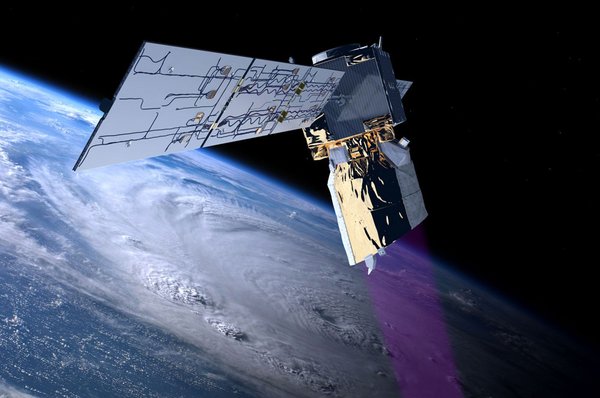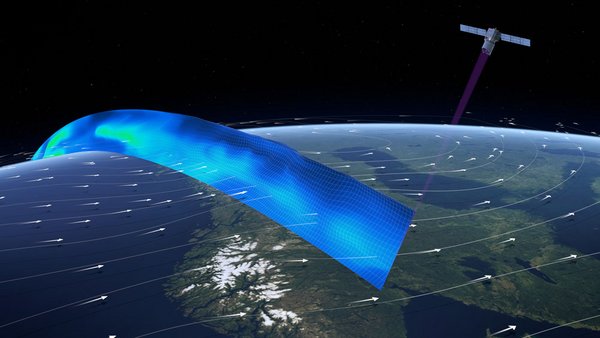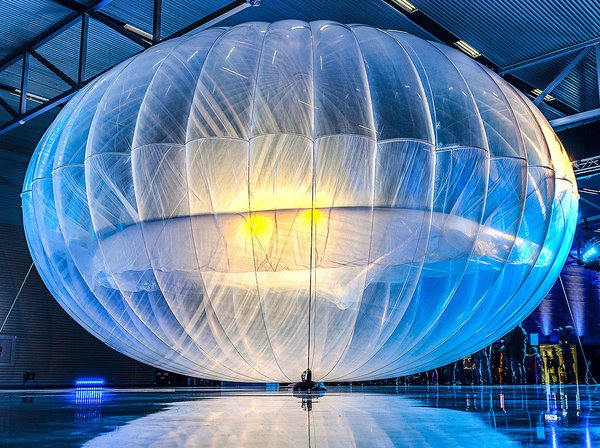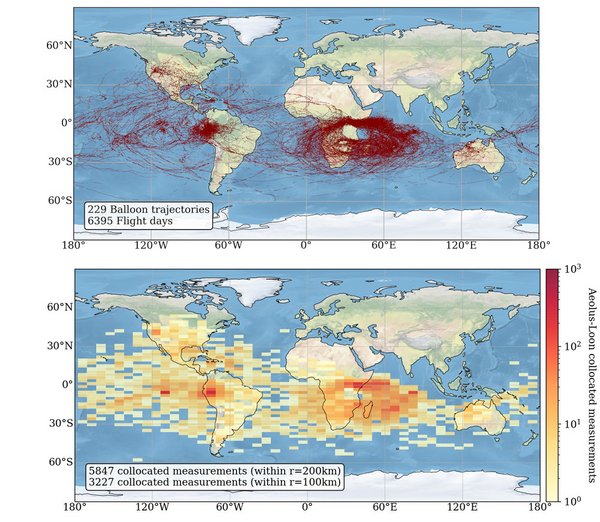Loon stratospheric balloons confirm wind data from Aeolus
Leipzig,
20.12.2022
Researchers recommend more vertical measurements for follow-up mission
Leipzig. ESA's novel Aeolus satellite reliably measures wind speed also in higher air layers and thus in a region of the atmosphere where other direct global wind measurements are relatively sparse. This is the result of a study for which data from the satellite were compared with wind observations from stratospheric balloons. Stratospheric balloons would provide highly accurate data on the horizontal wind speed and are therefore also suitable for the validation of future satellite missions. Future wind satellites should increase the vertical resolution to better resolve gravity waves in the tropics, writes the team of researchers from the Leibniz Institute for Tropospheric Research (TROPOS), the European Space Agency (ESA), the European Centre for Medium-Range Weather Forecasts (ECMWF), the University of Hamburg and the Google company Loon. The study has now been published in the Quarterly Journal of the Royal Meteorological Society.
The quality of numerical weather prediction models and thus of weather forecasts depends heavily on the available data. In recent decades, a global observation system has therefore been built up which also includes wind profiles from weather balloons, aircraft data or wind profiler radar systems. However, most of this data comes from the densely populated northern hemisphere. In the southern hemisphere, over the oceans and especially in the tropics, the network of direct measurements is still relatively sparse.
The launch of the European Space Agency's (ESA) first wind satellite Aeolus on 22 August 2018 was therefore a major step towards global wind measurements. This novel satellite has a powerful laser on board, the Atmospheric Laser Doppler Instrument (ALADIN). ALADIN is the first Doppler wind lidar in space to provide profiles of horizontal wind speed from the Earth's surface or from the top of thick clouds up to a height of about 30 km on a global scale. To do this, the satellite emits short ultraviolet laser pulses as it orbits the Earth. A small part of these light pulses is scattered back to the satellite by air molecules, aerosols and clouds and collected and processed in the detector there. For one circumnavigation of the globe Aeolus takes 90 minutes, within a week the satellite collects wind data around the entire globe. This data is assimilated by weather forecasting centres around the world to improve their forecasts. Since there have been no comparable satellite missions so far, the data are checked particularly critically and compared with other wind measurements.
A study recently published used data from 229 stratospheric balloons of the Loon project between July 2019 and December 2020 from tropical Latin America, Atlantic Ocean, Africa and Indian Ocean for comparison. Loon was a commercial project that had provided remote regions with internet access via helium balloons in the stratosphere. The balloons, which were about 12 metres in diameter, acted as floating mobile phone stations at altitudes of 16 to 20 kilometres above the ground. For maintaining the network, the balloons had to automatically correct the wind direction by changing the altitude. This created an extensive data set on wind speeds in these atmospheric layers, which partially fills the gap in wind data at this altitude in the global observation system. The Loon project was discontinued in 2021 for economic reasons, but a highly interesting data set remains for atmospheric research.
"Our analysis confirms that the Aeolus satellite provides almost bias-free wind measurements in the upper troposphere and lower stratosphere. In contrast, the current ECWMF weather model systematically underestimates the wind speed there by about 1 metre per second, which could be demonstrated by the Aeolus and Loon data. These results are important to better understand dynamical processes in the upper troposphere and lower stratosphere and to further improve the weather models," emphasises Dr. Sebastian Bley from TROPOS, who worked for the study at ESA in Frascati, Italy. Another recommendation of the researchers is to carry out more vertical measurements to be able to provide more wind information in the atmospheric layers. This could further improve the accuracy of upcoming wind satellites. In addition to wind speed, Aeolus also provides information about aerosols and clouds, but only via a portion of the backscattered light. "We hope that future wind missions will also be able to measure depolarisation, the rotation of light when it is reflected. That would be a milestone because the satellite could then also provide more information about aerosols," explains Bley.
Aeolus was developed as an explorer mission with an expected lifetime of 3 years to demonstrate the technology of a Doppler wind lidar in space. However, expectations have been exceeded and Aeolus has now been providing valuable data for over 4 years. The wind data are now used in the weather forecasts of several weather services throughout Europe, such as the German Weather Service (DWD), and have been convincing due to their positive influence on the quality of weather forecasts. The way forward for the follow-on mission Aeolus-2 has been recently decided in the ESA ministerial and will be jointly developed by ESA and EUMETSAT.
In September, researchers from the USA had integrated Aeolus data into the hurricane model (HWRF) of the US weather and oceanography agency NOAA on a trial basis in order to better predict tropical storms. Their conclusion is that the use of Aeolus wind data is most effective where there are no reconnaissance flights into the hurricanes and could therefore have the greatest positive impact on tropical cyclone forecasting in the Pacific and Indian Oceans.
With these two new studies from the tropics, the chances are increasing that Aeolus data will also be used outside Europe and that a follow-up mission could improve weather forecasts. Tilo Arnhold
Publication:
Bley, S., Rennie, M., Žagar, N., Pinol Sole, M., Straume, A.G., Antifaev, J., Candido, S., Carver, R., Fehr, T., von Bismarck, J., Hünerbein, A. and Deneke, H. (2022), Validation of the Aeolus L2B Rayleigh Winds and ECMWF Short-Range Forecasts in the Upper Troposphere and Lower Stratosphere using Loon Super Pressure Balloon Observations. Quarterly Journal of the Royal Meteorological Society, 148 (749), 3852– 3868. https://doi.org/10.1002/qj.4391
The research was funded by the European Space Agency (ESA) as part of the Aeolus DISC project (Data Innovation and Science Cluster).
Media contacts:
Dr. Sebastian Bley,
Department Remote Sensing of Atmospheric Processes, Leibniz Institute for Tropospheric Research (TROPOS)
Phone +49 341 2717-7171
https://www.tropos.de/en/institute/about-us/employees/sebastian-bley
and
Dr. Hartwig Deneke
Group Leader Satellite Remote Sensing, Department Remote Sensing of Atmospheric Processes, Leibniz Institute for Tropospheric Research (TROPOS)
Phone +49 341 2717-7168
https://www.tropos.de/en/institute/about-us/employees/hartwig-deneke
or
Tilo Arnhold
Public Relations, Leibniz Institute for Tropospheric Research (TROPOS)
Phone: +49-341-2717-7189
https://www.tropos.de/en/current-issues/press-releases
Further information and links:
ESA-Aeolus:
https://www.esa.int/Applications/Observing_the_Earth/FutureEO/Aeolus
ESA’s wind mission could help to forecast tropical storms (27 Oct 2022):
https://earth.esa.int/eogateway/news/esa-s-wind-mission-could-help-to-forecast-tropical-storms
Aeolus DISC (Data, Innovation, and Science Cluster)
https://earth.esa.int/eogateway/activities/aeolus-disc
EVAA - Experimentelle Validierung und Assimilation von Aeolus Beobachtungen
https://www.meteo.physik.uni-muenchen.de/evaa/doku.php?id=en:start
Large measurement campaign in the Atlantic starts (Press release, 30 Jun 2021)
https://www.tropos.de/en/current-issues/press-releases/details/grosse-messkampagne-im-atlantik-laeuft-an
Californian smoke drifted as far as Central Europe in autumn 2020 and caused heavy clouding of the sun (Press release, 01 Jun 2021)
https://www.tropos.de/en/current-issues/press-releases/details/kalifornischer-rauch-zog-im-herbst-2020-bis-nach-mitteleuropa-und-sorgte-fuer-starke-truebung-der-sonne
ADM Aeolus – Measuring the wind from space with a laser for the first time (Press release, 21 Aug 2018)
https://www.tropos.de/en/current-issues/press-releases/details/adm-aeolus-measuring-the-wind-from-space-with-a-laser-for-the-first-time
The Leibniz Institute for Tropospheric Research (TROPOS) is a member of the Leibniz Association, which connects 97 independent research institutions that range in focus from the natural, engineering and environmental sciences via economics, spatial and social sciences to the humanities. Leibniz Institutes address issues of social, economic and ecological relevance. They conduct knowledge-driven and applied basic research, maintain scientific infrastructure and provide research-based services.
The Leibniz Association identifies focus areas for knowledge transfer to policy-makers, academia, business and the public. Leibniz institutions collaborate intensively with universities – in the form of “Leibniz ScienceCampi” (thematic partnerships between university and non-university research institutes), for example – as well as with industry and other partners at home and abroad.
They are subject to an independent evaluation procedure that is unparalleled in its transparency. Due to the importance of the institutions for the country as a whole, they are funded jointly by the Federation and the Länder, employing some 20,500 individuals, including 11,500 researchers.
The entire budget of all the institutes is approximately 2 billion euros. They are financed jointly by the Federal Government and the Länder. The basic funding of the Leibniz Institute for Tropospheric Research (TROPOS) is therefore financed by the Federal Ministry of Education and Research (BMBF) and the Saxon State Ministry of Science and the Arts (SMWK). The Institute is co-financed with tax revenues on the basis of the budget approved by the Saxon State Parliament.
www.leibniz-gemeinschaft.de/en/home/
www.bmbf.de/en/index.html
https://www.smwk.sachsen.de/




